The Sheepgate's biblical story reveals secrets beyond its ancient stones, beckoning a deeper exploration of its enduring spiritual significance.
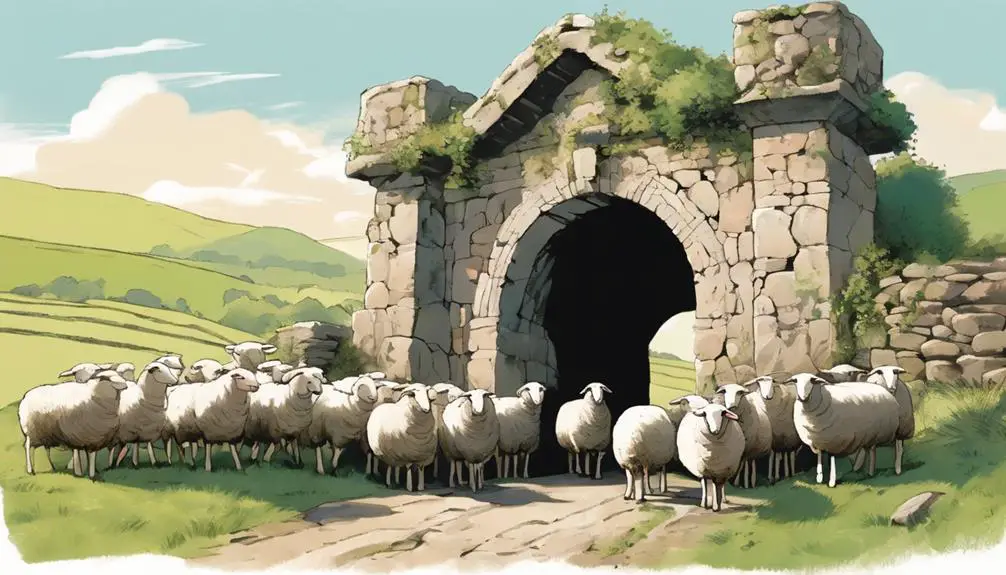
Sheepgate in the Bible
As you navigate the winding paths of history, you'll stumble upon the Sheepgate, a gem nestled within the tapestry of biblical narratives. This gate, more than just an architectural marvel, serves as a portal to understanding the daily life and spiritual symbolism in ancient times.
With its mention in the Bible, particularly in Nehemiah and the Gospel of John, you're invited to explore its historical background, biblical significance, and what it might symbolize in a modern context. The question isn't just what the Sheepgate was, but rather, what secrets and lessons it still holds for us today.
Why does it matter in our contemporary world? Let's uncover what lies beyond its ancient stones.
Key Takeaways
- Sheepgate played a pivotal role in ancient Jerusalem's economy and religious practices.
- It symbolizes themes of sacrifice, purification, and spiritual rebirth in biblical narratives.
- Architecturally, it was built with robust materials, reflecting its economic and religious significance.
- Modern interpretations link Sheepgate to themes of responsible stewardship and community care.
Historical Background
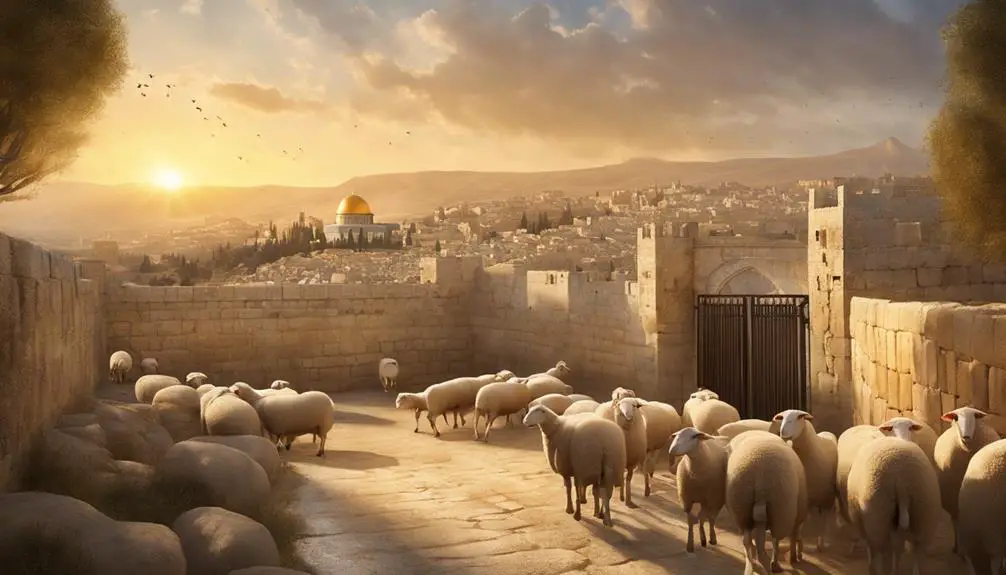
Delving into the historical background of Sheepgate, it's crucial to understand its significance in ancient Jerusalem's societal and economic structures. Positioned strategically, its geographic location served as a vital conduit for sheep trading, which was integral to the city's prosperity. This gate wasn't merely a physical entryway but a symbolic threshold, linking the pastoral hinterlands to the urban heart of Jerusalem. It facilitated the flow of goods, ideas, and cultural exchanges, cementing its role in the broader economic network.
Sheep trading, facilitated by Sheepgate, underscored the agricultural backbone of the region. The gate's proximity to the Temple, though not the focus here, indirectly influenced its prominence, as livestock were essential for religious rituals. This economic activity wasn't isolated; it interacted with various sectors, from textiles to food production, showcasing a diversified yet interconnected economy.
The gate's geographic location also allowed Jerusalem to control and regulate trade, ensuring the city's economic stability and security. This strategic positioning wasn't accidental but a testament to the meticulous planning and understanding of trade dynamics by ancient urban planners. Sheepgate, thus, was more than a mere entry point; it was a linchpin in the socio-economic fabric of ancient Jerusalem.
Biblical Mentions
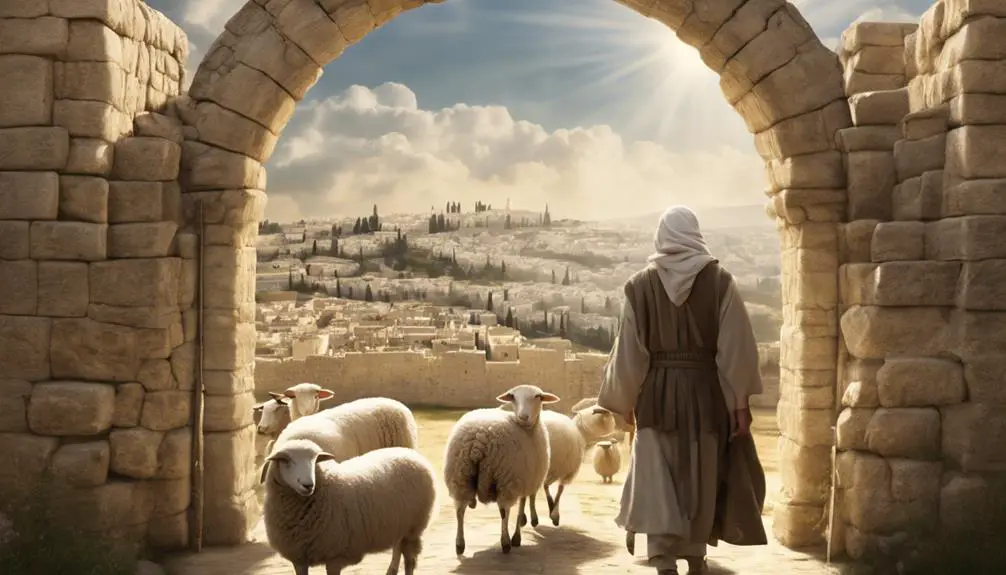
The Bible's narrative intricately weaves Sheepgate into its historical and spiritual tapestry, highlighting its significance in Jerusalem's religious practices. As you delve into the scripture, you'll find specific references that not only pinpoint geographical locations but also underscore the pivotal shepherd roles within these narratives. This analysis brings to light how integral Sheepgate was, not just as a physical entry point but as a cornerstone in the spiritual and communal life of ancient Jerusalem.
- Nehemiah 3:1 – Describes the rebuilding of Sheepgate, emphasizing its importance in Jerusalem's restoration efforts.
- Nehemiah 12:39 – Highlights the procession and dedication ceremonies, underscoring Sheepgate's role in religious observances.
- John 5:2 – Introduces Sheepgate in the New Testament, linking it to healing and miracles, thereby expanding its significance.
- Acts of geographical significance – Sheepgate served as a crucial point for the entry of sheep into Jerusalem for temple sacrifices.
- Shepherd roles – Scripture subtly illustrates how shepherd roles intertwined with Sheepgate, depicting it as a pathway for both literal and figurative guidance.
This scholarly examination uncovers the layers of meaning behind Sheepgate's mentions in the Bible, revealing a rich tapestry of faith, tradition, and community that transcends mere geographic locations.
Symbolic Significance

Sheepgate's symbolic value extends beyond its physical structure, embodying themes of sacrifice, purification, and redemption within biblical narratives. This gate, as mentioned in the scriptures, serves not just as a point of entry but also as a profound metaphor for the way religious practices and cultural interpretations intertwine in the fabric of faith. You'll find that its presence isn't merely historical but deeply embedded in the spiritual consciousness of communities, reflecting a pathway to holiness and connection with the divine.
In the context of religious practices, the passage through Sheepgate represents a journey of cleansing and preparation, a prerequisite for approaching the sacred. This aligns with the rituals of sacrifice, where purification was essential. The symbolism here is rich and multifaceted, suggesting layers of meaning from atonement to rebirth.
Cultural interpretations further enrich this symbolism, as different communities have seen in Sheepgate a mirror of their spiritual aspirations and religious ideals. It's a testament to how physical structures in the Bible can hold a wealth of spiritual significance, guiding believers in their faith journey. Through Sheepgate, you're invited to explore themes that are central not only to biblical times but also to the enduring human quest for redemption and spiritual fulfillment.
Architectural Features
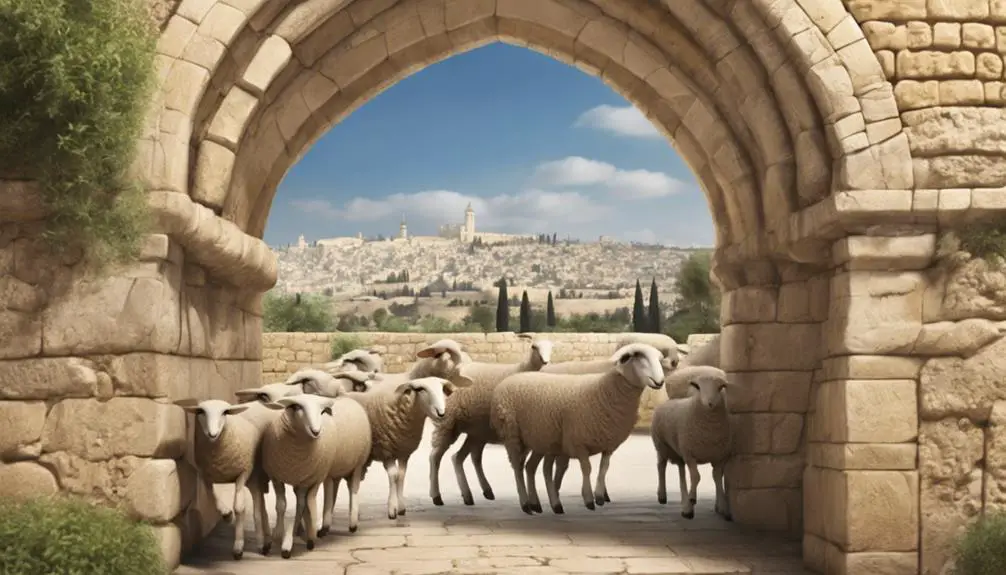
Exploring the architectural features of Sheepgate reveals an intricate design that served both practical and symbolic purposes in biblical times. The gate's construction showcases the exceptional craftsmanship and understanding of material choices and construction techniques of the era.
- Material Choices: Primarily built from locally sourced stone, Sheepgate's construction utilized materials that weren't only abundant but also symbolized strength and durability. The choice of stone over wood or other perishable materials ensured its longevity and significance within the city's fortifications.
- Construction Techniques: Employing advanced masonry skills, builders achieved a robust structure capable of withstanding both the elements and potential sieges. The precision in stone fitting minimized the need for mortar, showcasing an advanced understanding of architectural principles.
- Design Elements: The gate featured a distinctive archway, a testament to the architectural innovation of the time. This not only provided structural stability but also symbolized the entrance into a place of significance.
- Security Measures: Thick walls and a heavy, secure door protected the gate, emphasizing its role in the city's defense system.
- Symbolic Accents: Details in the stonework and the gate's strategic placement reflected its importance to the community, serving as a reminder of the city's reliance on sheep for economic and religious practices.
Modern-Day Relevance

While the architectural features of Sheepgate highlight its historical and cultural significance, its relevance extends into the modern era, offering insights into contemporary interpretations and applications of ancient design principles. You'll find that the ethical considerations embedded in the maintenance and use of Sheepgate resonate with today's emphasis on responsible governance and stewardship. The structure's purpose, facilitating the movement and care of sheep, parallels modern concepts of pastoral care in both religious and secular contexts, emphasizing the importance of guidance, protection, and nurturing.
The principles underlying Sheepgate's design and function serve as a metaphor for contemporary societal structures aimed at safeguarding and serving communities. In analyzing its significance, you're encouraged to consider how ancient wisdom can inform current practices, particularly in relation to ethical leadership and community care. The idea of a gate, as both a point of entry and a protective barrier, invites reflection on how societies manage access and provide security for their members while also ensuring freedom and care.
In essence, Sheepgate's enduring legacy lies not only in its physical structure but in its symbolic representation of care, oversight, and ethical considerations that remain pertinent in today's world.
Frequently Asked Questions
How Have Different Religious Traditions Interpreted the Significance of Sheepgate Throughout History Beyond Its Biblical Context?
You've likely wondered how religious traditions interpret Sheepgate's significance beyond its biblical roots. Analyzing Sheepgate's geography and construction techniques offers fascinating insights. Various faiths have delved into these aspects to understand its symbolic and practical values, viewing it as more than a historical footnote.
Scholarly analysis reveals that interpretations often reflect broader theological perspectives, showing how physical structures like Sheepgate can embody deep spiritual meanings across different religious landscapes.
Are There Any Specific Rituals or Ceremonies That Were Historically Performed at the Sheepgate That Don't Directly Relate to Its Architectural Features or Symbolic Significance?
You're exploring if any unique rituals or ceremonies historically took place at the Sheepgate unrelated to its architecture or symbolism.
It's essential to consider how market dynamics and urban development might've influenced such practices.
Although direct connections to specific rituals aren't easily traced, the gate's role in city life and economy likely shaped any ceremonies conducted there, deviating from purely religious functions to embody the social and economic fabric of the time.
How Has the Depiction of Sheepgate in Religious Art Evolved Over the Centuries, and What Unique Interpretations or Symbolic Meanings Have Artists Conveyed?
The depiction of Sheepgate in religious art has significantly evolved, reflecting various artistic techniques and materials. Initially, artists focused on literal interpretations, utilizing conventional materials.
Over centuries, unique interpretations emerged, with artists exploring symbolic meanings, employing diverse materials and innovative techniques. These changes not only demonstrate artistic evolution but also highlight the shifting perceptions of Sheepgate's significance, offering deeper insights into its role and symbolism in religious contexts.
Can You Provide Examples of How Sheepgate Has Influenced Modern Literary Works or Popular Culture Outside of Its Direct Biblical Mentions or Historical Background?
You'll find that Sheepgate's influence extends into modern literary works and pop culture, often serving as a deep well of literary symbolism and cultural references. It's subtly woven into narratives, symbolizing themes of guidance, entry, or salvation.
Authors and creators draw from its rich symbolic heritage to craft stories that resonate with these themes, offering fresh takes that mightn't explicitly mention Sheepgate but echo its profound symbolic legacy.
What Are the Ecological or Environmental Impacts, if Any, of Maintaining or Reconstructing Historical Sites Like Sheepgate in Contemporary Times?
Maintaining or reconstructing historical sites today, you face ecological impacts. Urban sprawl, driven by expanding such sites, encroaches on natural habitats, leading to biodiversity loss.
It's not just about taking up space; it's about the ripple effects on local ecosystems. You've got to weigh cultural preservation against environmental sustainability.
Careful planning and innovative design can mitigate these impacts, preserving history without compromising the environment's health. It's a delicate balance to strike.
Conclusion
In conclusion, you've explored the Sheep Gate's multifaceted role within biblical contexts, from its historical roots to its symbolic meanings and architectural characteristics. Its mentions in the Bible underscore its significance, not just as a physical entryway but as a spiritual symbol, reflecting themes of sacrifice and redemption. Moreover, its enduring relevance today speaks to the depth of its impact on both ancient and modern understandings of faith.
Through this analysis, you've gained a comprehensive insight into the Sheep Gate's enduring legacy.


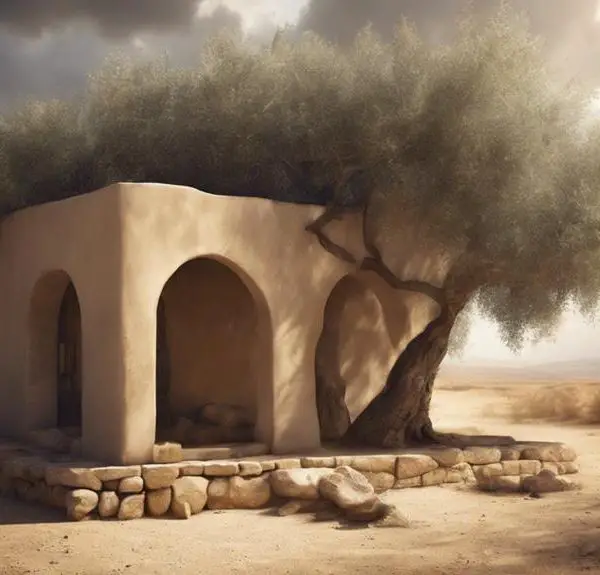
Sign up